
Best Hospital Beds for Elderly at Home (Electric + Manual Compared)
Key Takeaways
- Electric hospital beds offer superior adjustability with powered head, foot, and height controls, but cost more ($1,200-$4,500) than manual models
- Hi-Lo hospital beds provide safer transfers with adjustable height ranges (as low as 7" from floor to 30" high) ideal for fall prevention
- Bariatric hospital beds support weights up to 750 lbs with reinforced frames and wider surfaces (42"-60")
- Ultra-low beds descend to 7"-9" from the floor, creating the safest option for elderly with fall risks
- Side rails are essential safety features available in full-length, half-length, and assist bar options
- Medicare typically covers 80% of the cost of medically necessary hospital beds with a doctor's prescription
- Top brands include Medacure, Costcare, Icare, Prius Healthcare, and Emerald for reliability and quality
When caring for an elderly loved one at home, a specialized hospital bed can significantly improve safety, comfort, and caregiver convenience. Unlike standard beds, hospital beds for the elderly offer adjustable features that help with positioning, transfers, and medical care delivery. They also support better sleep and reduce the risk of bed sores for those with limited mobility.
After thorough research and analysis, the Icare Adjustable Electric Home Hospital Bed - IC333 emerges as the best overall hospital bed for elderly home care. With its premium design that looks less institutional, full electric adjustability, and excellent weight capacity, it offers the perfect balance of functionality, comfort, and aesthetics for long-term use.
In this comprehensive guide, I'll walk you through everything you need to know about choosing the best hospital bed for elderly care at home. I'll compare electric versus manual options, highlight crucial features to look for, and recommend top models that balance comfort, functionality, and value.
Types of Hospital Beds for Elderly Home Care
When selecting a hospital bed for elderly home care, the first major decision is choosing between manual and electric models. Each has distinct advantages depending on the user's needs and budget constraints.
Electric Hospital Beds
Electric hospital beds use motors to adjust various positions with the press of a button, making them ideal for users with limited mobility and caregivers who need to make frequent adjustments.
Key benefits of electric hospital beds:
- Remote-controlled adjustments: Change head, foot, and height positions without physical effort
- Independent operation: Elderly users can adjust their own position without assistance
- Smoother transitions: Gradual adjustments reduce strain and discomfort
- Preset positions: Many models offer programmable settings for common positions
A great example is the Costcare Full Electric Hospital Bed B135C, which provides full electric adjustment capabilities at a price point of $1,298. This model features a quiet motor system and includes a user-friendly remote with backlit buttons for nighttime use.
For those who need more robust options, the recommended Icare Adjustable Electric Home Hospital Bed - IC333 offers premium features like advanced positioning and higher weight capacities, starting at $3,200.
Manual Hospital Beds
Manual hospital beds use hand cranks to adjust positions, making them a more affordable option with fewer potential mechanical issues.
Key benefits of manual hospital beds:
- Lower cost: Typically $400-800 cheaper than comparable electric models
- No electricity required: Functions during power outages
- Fewer mechanical parts: Less prone to electrical failures
- Simpler maintenance: Easier to repair and maintain
Manual beds are best suited for situations where:
- Budget is a primary concern
- Adjustments are made infrequently
- A caregiver is always available to help with position changes
- The home has frequent power outages
While fully manual models are becoming less common in home care, semi-electric options like the Costcare Semi-Electric Bed B120C priced at $1,068 offer a good compromise. These beds typically feature electric head and foot adjustments with manual height control.
Hi-Lo Hospital Beds
Hi-Lo hospital beds are designed to raise and lower the entire sleeping surface, allowing for easier transfers and caregiver access. These beds are particularly valuable for elderly individuals who:
- Need assistance getting in and out of bed
- Are at risk for falls
- Receive regular care that requires different working heights
- Transfer between bed and wheelchair regularly
The Medacure Ultra Low Hospital Bed ULB7/30-CLS represents a great option in this category, with a height range from 7" to 30" and a locking system for extra stability at $1,741.
Similarly, the Icare High Low Hospital Bed IC222 offers exceptional adjustability with a sleek design that looks less institutional, starting at $2,800.
Bariatric Hospital Beds
For elderly individuals who need extra support, bariatric hospital beds provide reinforced frames and wider sleeping surfaces to safely accommodate higher weight capacities.
Key features of bariatric hospital beds:
- Higher weight capacity: Typically support 500-1000 pounds
- Wider sleeping surface: Available in 42", 48", 54" and 60" widths
- Reinforced frame: Extra durability for long-term use
- Heavy-duty motors: Stronger lifting capacity for adjustments
The Full Electric Bariatric Hospital Bed Costcare B142C is an excellent entry-level option at $1,842, supporting up to 600 pounds.
For those needing more advanced features, the Costcare Bariatric Adjustable Hospital Bed B359 offers expandable width options between 54"-60" and supports up to 750 pounds at $3,457.
Essential Features to Consider for Elderly Care
When selecting a hospital bed for an elderly loved one, certain features can significantly improve safety, comfort, and ease of use for both the user and caregiver.
Adjustable Height Range
One of the most important features in a hospital bed for elderly care is height adjustability. This function serves several critical purposes:
- Transfer safety: Lower heights (9"-13") make it safer for an elderly person to get in and out of bed
- Fall prevention: Ultra-low beds that descend to 7"-9" minimize injury risk if falls occur
- Caregiver ergonomics: Higher positions (26"-30") reduce back strain for caregivers during care tasks
The Ultra Low Hospital Bed Medacure ULB3.9 excels in this category, with an extremely low 3.9" height capability when fully lowered, making it one of the safest options for elderly with significant fall risk. This bed ranges from $2,240 to $2,440 depending on configuration.
For maximum height flexibility, the Prius Electric Hospital Bed offers a range from 7" to 30" with smooth transitions, though it comes at a premium price point of $9,750.
Side Rails and Safety Features
Side rails are essential safety components that prevent falls while also giving elderly users something to grip when repositioning themselves. When evaluating side rail options, consider:
- Coverage length: Full-length rails provide maximum protection, while half-rails allow easier access
- Locking mechanisms: Ensure rails lock securely in both raised and lowered positions
- Gap protection: Rails should prevent entrapment risks with appropriate spacing
- Assist functionality: Some rails double as mobility aids for sitting up or repositioning
Many beds come with side rails included, but check whether they're half or full rails. The Costcare Homecare Half Rails Model BPR120C are popular add-ons for basic protection.
For enhanced mobility support, the Icare Occupation Therapist U-Assist Side Rail provides both fall protection and a sturdy handle for repositioning.
Weight Capacity
Ensuring adequate weight capacity is crucial for safety and longevity of the bed. Standard hospital beds typically support:
- Regular hospital beds: 350-450 pounds
- Heavy-duty beds: 500-600 pounds
- Bariatric beds: 600-1000 pounds
The Heavy Duty Hospital Bed Costcare B357 supports up to 600 pounds and offers flexible width and length adjustments for $3,142.
For those needing maximum support, the Medacure Bariatric Adjustable Bed Lincoln LX-BARI-S includes a built-in scale and supports up to 750 pounds for $3,495.
Trendelenburg and Reverse Trendelenburg Positioning
Advanced positioning options like Trendelenburg (head down, feet up) and Reverse Trendelenburg (head up, feet down) can be extremely beneficial for certain medical conditions common in elderly patients:
- Respiratory support: Reverse Trendelenburg helps with breathing difficulties
- Circulation improvement: Trendelenburg assists with proper blood flow
- Edema management: Elevation helps reduce swelling in extremities
- Pressure relief: Position changes help prevent pressure ulcers
The Trendelenburg Costcare Adjustable Medical Bed B337 offers these specialized positioning features at $1,675, making it an excellent value for those who need these therapeutic positions.
For a more advanced option, the Costcare Trendelenburg Adjustable Hospital Bed B730 provides smoother transitions and more precise angle adjustments at $4,300.
Top Hospital Beds for Specific Elderly Needs
Different elderly individuals have varying needs based on their mobility, size, and medical conditions. Here are specialized recommendations based on common scenarios in elderly home care.
Best for Fall Prevention: Ultra-Low Beds
For elderly individuals with dementia, disorientation, or history of falls, ultra-low beds that can be positioned very close to the floor provide maximum safety.
The Low Profile Hospital Bed Prius Descend Ultra offers exceptional fall protection with its near-floor height capability and sturdy stabilization system for $2,450.
Another excellent option is the Costcare Ultra Low Hospital Bed B437, which combines an ultra-low height with half-length side rails for $1,857.
Key features to look for in fall prevention beds:
- Floor height of 7" or lower when fully descended
- Easy-to-use controls for quick height adjustments
- Lockable wheels for stability
- Compatible with floor mats for additional protection
Best for Caregivers: Hi-Lo Beds with Ergonomic Features
For situations involving regular caregiving, beds that prioritize caregiver ergonomics while maintaining patient comfort are essential.
The TransferMaster Full Electric Hi-Lo Hospital Bed Supernal 3 features a large height range and programmable positions to make caregiving tasks easier, starting at $3,441.
For advanced care needs, the Adjustable Hospital Bed Medecure ULB48-X-7/30-CLS offers auto-contour features that simultaneously adjust head and knee positions for optimal positioning at $1,950.
Features caregivers should prioritize include:
- Maximum height of at least 26" for back-saving care
- Central locking wheels for stability during care
- Accessible emergency controls
- Quick-release side rails for emergencies
Best for Bariatric Needs: Heavy-Duty with Width Options
For elderly individuals who require a wider sleep surface and reinforced support, several excellent bariatric options are available.
The Full Electric Bariatric Bed Emerald Oasis Infinity offers a comfortable sleep surface with width options from 36" to 48" and supports up to 600 pounds for $2,334.
For even more robust support, the Full Electric Bariatric Hospital Bed Emerald Oasis Infinity Max accommodates users up to 54" wide and supports up to 750 pounds for $4,239.
When selecting bariatric beds, look for:
- Reinforced frame construction
- Heavy-duty motors with smooth operation
- Width expansion capabilities
- Compatible bariatric mattress options
- Distributed weight support across the entire frame
Best for Limited Space: Compact and Efficient Designs
For home environments with space limitations, several hospital beds offer full functionality in more compact designs.
The Emerald Hospital Adjustable Bed Oasis 52200 features a space-efficient design while maintaining full electric functionality for $1,940.
For customizable dimensions, the Costcare Hospital Adjustable Bed B325 offers configurable height and length options to fit various room sizes for $1,735.
Space-saving features to consider:
- Streamlined frame designs
- Wall-hugging technology that maintains position during adjustments
- Compact control systems
- Compatible with space-saving accessories
Mattress and Accessory Considerations
The right hospital bed mattress and accessories are crucial for comfort, pressure relief, and overall effectiveness of the hospital bed system for elderly care.
Pressure Relief Mattresses
For elderly individuals who spend extended time in bed, pressure relief mattresses are essential to prevent pressure ulcers (bedsores) and ensure comfort.
Key mattress types to consider:
-
Foam mattresses: Multi-layer foam provides basic support and moderate pressure relief
- Example: Emerald 5-Zone Medical Foam Mattress
-
Memory foam mattresses: Conforms to body shape for enhanced pressure distribution
-
Alternating pressure mattresses: Air cells inflate and deflate to continuously redistribute pressure
-
Low air loss mattresses: Circulate air beneath the patient to manage moisture and heat
For those with higher risk of skin breakdown, the Medacure Pro Dynamic True Low Air Loss Hospital Bed Mattress offers advanced therapeutic pressure management.
Essential Bed Accessories for Elderly Care
Beyond the bed and mattress, several accessories can significantly improve elderly comfort and caregiver efficiency:
-
Overbed tables: Provide a surface for meals, activities, and personal items
- Options include Icare Over Bed Table with C-shape Base for easy positioning
-
Bed assist rails: Help with repositioning and transfers while providing fall protection
- The Emerald Q Assist Bar offers support without full side rails
-
Mattress protectors: Waterproof covers protect expensive mattresses from spills
- Icare Mattress Cover - Fully Enclosed provides complete protection
-
Specialized pillows: Support proper positioning for comfort and prevention
- Icare High Density Contour Pillow provides neck and shoulder support
-
Trapeze bars: Overhead assists that help users reposition themselves
- Icare Homecare Over Bed Pole adds independence for stronger users
Cost Considerations and Insurance Coverage
Understanding hospital bed costs and potential coverage options is essential for making an informed decision.
Price Ranges for Hospital Beds
Hospital bed prices vary significantly based on features, brand, and capabilities:
- Basic manual/semi-electric beds: $800-$1,500
- Full electric standard beds: $1,200-$2,500
- Hi-Lo specialized beds: $1,800-$3,500
- Bariatric specialized beds: $2,000-$4,500
- Premium beds with advanced features: $3,500-$10,000
Additional costs to consider include:
- Mattress: $200-$2,000 depending on type
- Side rails: $100-$300 per pair if not included
- Delivery and setup: $0-$350 depending on location and service
- Extended warranties: $200-$500 depending on coverage
Medicare and Insurance Coverage
For elderly individuals, Medicare may cover a significant portion of hospital bed costs when medically necessary:
- Medicare Part B: Typically covers 80% of the approved amount for durable medical equipment (DME) including hospital beds when prescribed by a doctor
- Medicare Advantage: Coverage varies by plan, but often follows original Medicare guidelines
- Supplemental insurance: May cover the remaining 20% not covered by Medicare
- Medicaid: May provide coverage for those who qualify financially
To qualify for Medicare coverage, the hospital bed must be:
- Prescribed by a doctor for a medical reason
- Necessary for a medical condition (not just for comfort)
- For use in the home
- Provided by a Medicare-approved supplier
Documentation needed typically includes:
- Doctor's prescription detailing medical necessity
- Face-to-face evaluation by healthcare provider
- Detailed written order with specific features required
- Documentation of the medical condition requiring the bed
Comparing Top Brands for Home Hospital Beds
Several reputable brands dominate the home hospital bed market, each with unique strengths and specializations.
Medacure
Medacure specializes in high-quality hospital beds with attention to safety features and durability.
Strengths:
- Extensive ultra-low bed options for fall protection
- Advanced Trendelenburg positioning on many models
- Expandable width options on several beds
- Built-in scale options for medical monitoring
Popular models:
- Ultra Low Hospital Bed Medacure ULB3.9: Superior fall protection
- Medacure Bariatric Adjustable Bed Lincoln LX-BARI-S: Integrated scale system
Costcare
Costcare offers a balanced approach with reliable beds at various price points.
Strengths:
- Extensive product range from basic to advanced
- Good value for standard features
- Both standard and bariatric options
- User-friendly controls
Popular models:
- Costcare Semi-Electric Bed B120C: Budget-friendly starter option
- Heavy Duty Hospital Bed Costcare B357: Flexible dimensions for various needs
Icare
Icare focuses on premium features with home-friendly designs. 
Strengths:
- Less institutional appearance
- Premium comfort features
- Comprehensive accessory ecosystem
- High-quality construction
Popular models:
- Icare Adjustable Electric Home Hospital Bed - IC333: Premium home-friendly design
- Icare High Low Hospital Bed- IC222: Balance of features and aesthetics
Emerald
Emerald provides reliable beds with strong value propositions.
Strengths:
- Good balance of features and affordability
- Strong bariatric selection
- Intuitive controls
- Space-efficient designs
Popular models:
- Emerald Hospital Adjustable Bed Oasis 52200: Excellent starter option
- Full Electric Bariatric Bed Emerald Oasis Infinity: Quality bariatric support
Prius Healthcare
Prius Healthcare specializes in advanced technology for complex care needs.
Strengths:
- Cutting-edge positioning technology
- Superior height range capabilities
- Advanced caregiver features
- Premium construction quality
Popular models:
- Prius Electric Hospital Bed: Advanced programming and positioning
- Low Profile Hospital Bed Prius Descend Ultra: Superior floor-height technology
Our Top Pick: Icare Adjustable Electric Home Hospital Bed - IC333
After examining all options across various categories, the Icare Adjustable Electric Home Hospital Bed - IC333 stands out as our top recommendation for elderly home care for several key reasons:
-
Home-friendly aesthetics: Its design blends medical functionality with residential appearance, making it less institutional-looking than many competitors.
-
Comprehensive adjustability: Full electric controls allow independent operation for both the elderly user and caregivers.
-
Quality construction: Premium materials and engineering ensure stability, safety, and longevity.
-
Accessory ecosystem: Compatible with a wide range of Icare accessories for customized care solutions.
-
Height range flexibility: Suitable for both fall prevention and caregiver ergonomics.
For those on a tighter budget, the Costcare Full Electric Hospital Bed B135C offers excellent value at $1,298 with all essential electric features.
For bariatric needs, the Full Electric Bariatric Hospital Bed Costcare B142C provides the best combination of capacity and value at $1,842.
For maximum fall prevention, the Ultra Low Hospital Bed Medacure ULB3.9 is unmatched with its 3.9" minimum height.
Setup and Maintenance Considerations
Proper setup and ongoing maintenance ensure the longevity and safety of a hospital bed for elderly care at home.
Installation and Room Preparation
Before your hospital bed arrives, prepare the room properly:
-
Space requirements:
- Allow 3-4 feet of clearance on each side for caregiver access
- Ensure 5-6 feet in front of the bed for wheelchair transfers
- Confirm hallways and doorways accommodate delivery (typically need 32-36" clearance)
-
Electrical needs:
- Position bed near electrical outlets
- Avoid extension cords or use medical-grade options if necessary
- Consider backup power options for electric beds
-
Flooring considerations:
- Remove throw rugs that could cause tripping
- Consider installing non-slip flooring
- Prepare for wheel locks on specific surfaces
Most retailers offer delivery options:
- Threshold delivery: Bed parts delivered to your door
- White glove delivery: Complete setup and installation
- Setup training: Staff demonstrates proper bed operation
Long-Term Maintenance and Care
Regular maintenance ensures safe operation and extends the bed's useful life:
-
Daily checks:
- Inspect side rails for secure locking
- Check electrical cords for damage
- Test remote control functions
- Verify wheel locks engage properly
-
Weekly maintenance:
- Clean all surfaces with appropriate disinfectants
- Lubricate moving parts per manufacturer instructions
- Check mattress for signs of wear or damage
- Tighten any loose hardware
-
Monthly inspections:
- Examine frame for cracks or damage
- Test emergency functions (manual cranks, battery backup)
- Verify weight capacity hasn't been exceeded
- Check for unusual noises during operation
Some retailers offer service contracts and extended warranties worth considering, particularly for electric beds with complex components. These typically range from $200-$500 depending on coverage length.
Frequently Asked Questions
Will Medicare cover the cost of a hospital bed for home use?
Medicare Part B covers 80% of the approved amount for hospital beds when they're medically necessary and prescribed by a doctor. To qualify, the bed must be required for a specific medical condition, not just for comfort or convenience. You'll need proper documentation including a doctor's prescription detailing medical necessity and a face-to-face evaluation. Medicare Advantage plans typically follow similar guidelines but may have different approved suppliers.
How do I know if my elderly parent needs a hospital bed?
Consider a hospital bed if your parent: has difficulty getting in and out of bed, needs frequent position changes, requires elevated head or foot positions for medical reasons (like breathing problems or edema), is at risk for falls, or receives regular care that would be easier with an adjustable bed. Consult with their healthcare provider who can assess their specific needs and provide appropriate recommendations based on mobility, medical conditions, and caregiver requirements.
What's the difference between semi-electric and fully electric hospital beds?
Semi-electric hospital beds have electric motors for head and foot adjustments but manual cranks for height adjustments. This makes them more affordable ($1,000-$1,500) while still providing the most commonly used electric functions. Fully electric beds ($1,200-$2,500) feature motors for all adjustments including height, offering maximum convenience but at a higher cost. Semi-electric beds are good options when height adjustments are infrequent, while fully electric models provide complete independence and are better for frequent position changes.
Can hospital beds be disguised to look more like regular bedroom furniture?
Yes, many modern hospital beds can be made to look more like regular furniture. Options include: wooden headboards and footboards that attach to hospital bed frames, bed skirts and specialized coverlets designed for adjustable beds, platform conversions that conceal the mechanical components, and designer models specifically made to resemble residential furniture. Brands like Icare and TransferMaster offer more home-friendly designs, while companies like Medacure offer optional headboard and footboard accessories in various finishes.
How wide are hospital beds compared to regular beds?
Standard hospital beds are typically 36" wide (compared to 38" for a regular twin bed). Wider options include: 42" mid-size beds, 48" expanded beds, and 54"-60" bariatric beds. In comparison, regular residential beds measure 38" (twin), 54" (full), 60" (queen), and 76" (king). When measuring for a hospital bed, remember to account for side rails, which can add 2-4" to the overall width, and ensure doorways and hallways can accommodate the bed's dimensions during delivery.
What mattress options work with hospital beds?
Hospital beds require specialized mattresses designed to flex with the bed's adjustable sections. Options include: basic foam mattresses ($200-$500) for general support, memory foam mattresses ($400-$900) for enhanced pressure relief, alternating pressure mattresses ($800-$1,500) that actively reduce pressure points by inflating and deflating air cells, and low air loss mattresses ($1,200-$2,000) that provide continuous airflow to manage moisture and heat. Always verify the mattress dimensions match your specific hospital bed, as non-standard sizes may require custom mattresses.
Are side rails required on hospital beds for home use?
Side rails aren't legally required for home hospital beds, but they're highly recommended for safety, especially for elderly individuals with mobility issues, cognitive impairments, or fall risks. Options include full-length rails (maximum protection), half-rails (balance between access and protection), and quarter-rails or assist bars (primarily for repositioning aid). Some facilities discourage certain rail configurations due to entrapment risks, so consider the specific needs of the user and consult healthcare providers for appropriate recommendations.





















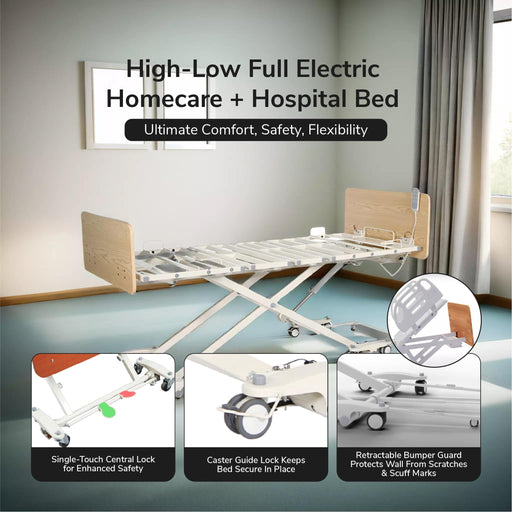
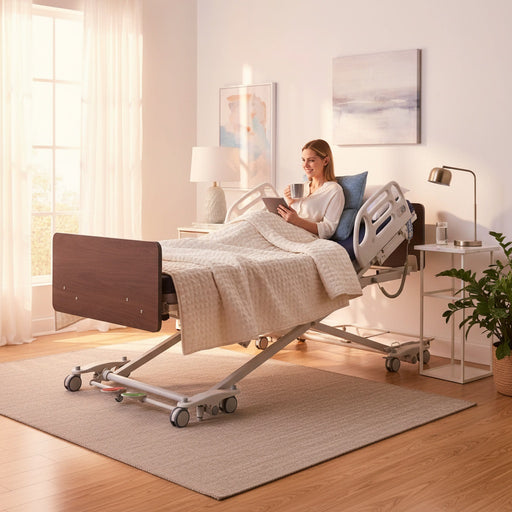
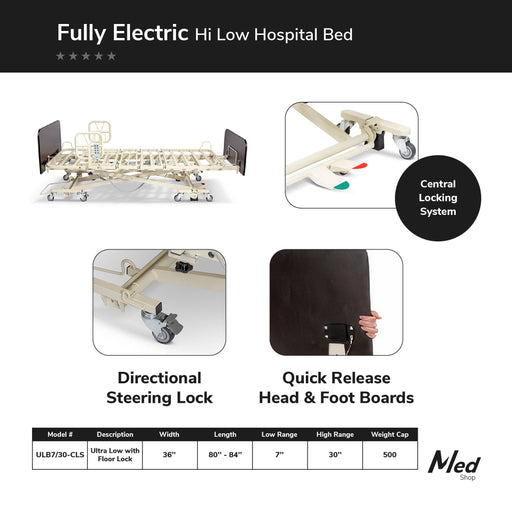
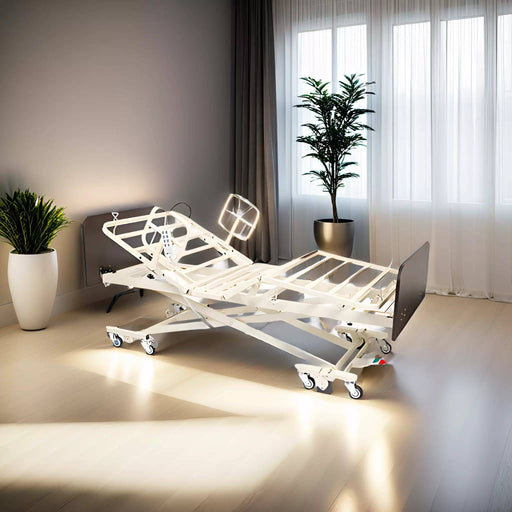


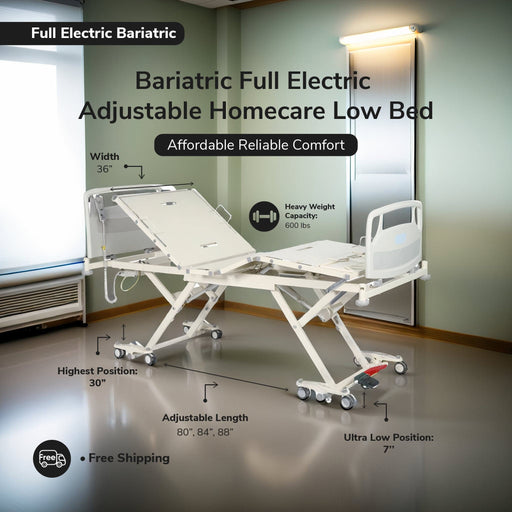
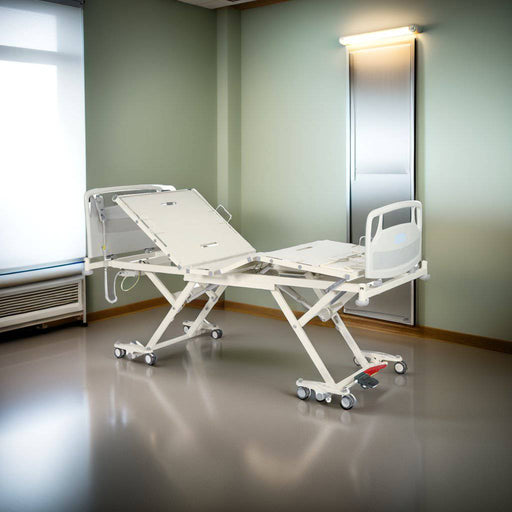
Leave a comment